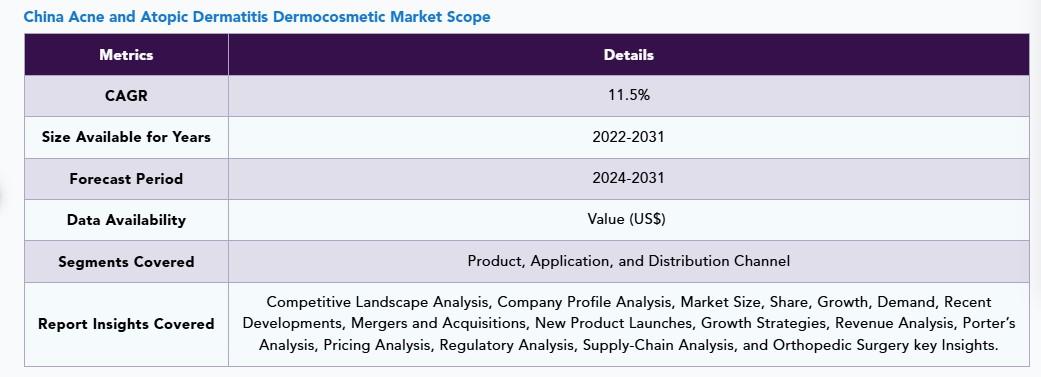China Acne and Atopic Dermatitis Dermocosmetic Market to Reach USD 1,068.7 Million by 2031, Growing at 11.5% CAGR

The China Acne and Atopic Dermatitis Dermocosmetic Market was valued at USD 455.5 million in 2022 and is expected to register significant growth, reaching USD 1,068.7 million by 2031 at a CAGR of 11.5% during the forecast period (2024–2031). Growth is being propelled by rising skin health concerns, an expanding middle-class population, and a cultural shift toward premium skincare products backed by dermatological expertise.
Download Sample report: https://www.datamintelligence.com/download-sample/china-acne-and-atopic-dermatitis-dermocosmetic-market?un

Market Growth Drivers
China has emerged as one of the largest beauty and skincare markets globally, and dermocosmetics targeting acne and atopic dermatitis are gaining strong traction. Acne remains highly prevalent among teenagers and young adults, while atopic dermatitis cases are on the rise due to pollution, changing lifestyles, and growing urbanization. These conditions are fueling demand for scientifically backed dermocosmetic solutions that combine skincare with therapeutic benefits.
The increasing awareness about skin health among Chinese consumers is another major driver. With a strong influence of social media, beauty influencers, and dermatologists, people are seeking evidence-based skincare formulations that provide both cosmetic and medical benefits. Dermocosmeticsproducts positioned between traditional cosmetics and pharmaceutical treatments are filling this demand gap effectively.
China’s growing disposable income and premiumization trend are also key market stimulants. The middle-class and affluent consumer base is more willing to invest in specialized skincare solutions, particularly products developed by dermatologists or recommended by healthcare professionals. Multinational companies and local brands alike are launching advanced formulations catering to sensitive skin, further accelerating adoption.
Market Challenges
Despite strong growth potential, the China acne and atopic dermatitis dermocosmetic market faces several challenges. High product costs limit accessibility for lower-income consumers, particularly in rural regions where awareness levels are also comparatively lower. The dominance of counterfeit products and unregulated skincare items creates hurdles for genuine dermocosmetic brands to build trust among consumers.
In addition, regulatory complexities pose a challenge for international companies. China’s cosmetic and medical product regulations require extensive testing and approvals, which can delay new product launches. Furthermore, consumer skepticism toward international versus domestic brands can influence purchasing decisions, with some preferring imported products while others lean toward locally manufactured ones.
Regional and Consumer Insights
The demand for acne and atopic dermatitis dermocosmetics is particularly concentrated in urban areas such as Beijing, Shanghai, Guangzhou, and Shenzhen, where consumers are more aware of skincare innovations and have higher purchasing power. Younger demographics, especially Gen Z and Millennials, form the largest consumer group for acne-related products, while atopic dermatitis dermocosmetics see higher demand among children and middle-aged adults caring for sensitive skin conditions.
The rise of online retail channels and e-commerce platforms such as Tmall, JD.com, and Xiaohongshu has transformed product accessibility. Consumers are increasingly purchasing dermocosmetics online due to convenience, product variety, and promotional campaigns driven by beauty influencers and dermatologists. Offline channels like specialty skincare clinics, dermatology hospitals, and pharmacies also play a significant role in boosting consumer trust.
Market Segmentation
By Product: Cleansers, Moisturizers/Lotions, Face cream, Lotion, Cleansing Oil, Cleansing Mask, Serum, Face Wash, Others.
By Application: Acne, Atopic Dermatitis (AD).
By Distribution Channel: Retail Store, E-Commerce, Others.
Buy an Exclusive copy of this report: https://www.datamintelligence.com/buy-now-page?report=china-acne-and-atopic-dermatitis-dermocosmetic-market
Competitive Landscape
The market is highly competitive, with both global and local players introducing targeted product lines. International skincare and dermocosmetic giants have strengthened their presence in China through partnerships, localized R&D, and e-commerce penetration. At the same time, domestic brands are rapidly expanding, focusing on affordable solutions customized to local skin types and conditions.
Key players include:
Johnson & Johnson, L’Oreal S.A., Procter & Gamble Co., Galderma SA, Pierre-Fabre SA, LА PRAIRIE, Proya Cosmetics Co., Ltd., Marubi Biotechnology Co., Ltd., Beijing Dabao Cosmetics Co., Ltd., and Shanghai Jahwa United Co., Ltd. among others.
Winona, in particular, has emerged as a domestic leader in dermocosmetics, gaining consumer trust through dermatologist-endorsed products tailored for sensitive skin. International brands like La Roche-Posay and Avène remain dominant in the acne and atopic dermatitis segment due to their clinical reputation and long-standing presence in dermatology.
Market Opportunities
The China Acne and Atopic Dermatitis Dermocosmetic Market offers multiple opportunities for innovation and expansion:
Personalized Skincare Solutions — Demand for AI-driven and customized dermocosmetics tailored to individual skin profiles is increasing.
Children’s Skincare Segment — Rising incidence of atopic dermatitis among children presents untapped growth potential.
Sustainable and Clean Beauty — Eco-friendly, non-toxic, and sustainable formulations are gaining traction among younger consumers.
Dermatology Partnerships — Collaborations between dermocosmetic companies and healthcare providers enhance credibility and market penetration.
E-Commerce Growth — Online retail platforms and livestreaming sales are powerful tools for expanding market reach.
Market Outlook
The China Acne and Atopic Dermatitis Dermocosmetic Market is set to experience dynamic growth over the next decade, supported by changing consumer lifestyles, higher healthcare spending, and growing acceptance of dermocosmetics as part of daily skincare. By 2031, the market will evolve into a more innovation-driven, consumer-centric, and regulated ecosystem, balancing premium international products with cost-effective domestic solutions.
As more consumers embrace holistic skincare backed by dermatological science, brands investing in R&D, localized formulations, and sustainability will capture the largest share of this rapidly expanding market.
Subscribe for more Industry reports: https://www.datamintelligence.com/reports-subscription
About Us
DataM Intelligence is a global market research and consulting firm delivering strategic insights across 40+ industries. With over 6,300 syndicated and customized reports and clients spanning 50+ countries, we guide businesses through trend navigation, performance acceleration, and data-driven decisions.
Contact Us
Company: DataM Intelligence
Contact: Sai Kiran
Email: sai.k@datamintelligence.com
Phone: +1 877 441 4866
Website: www.datamintelligence.com
- Art
- Causes
- Crafts
- Dance
- Drinks
- Film
- Fitness
- Food
- Games
- Gardening
- Health
- Home
- Literature
- Music
- Networking
- Other
- Party
- Religion
- Shopping
- Sports
- Theater
- Wellness


